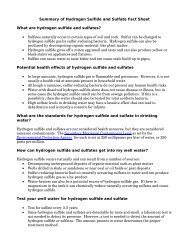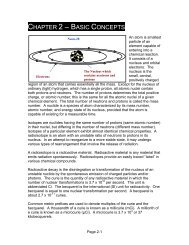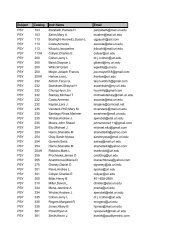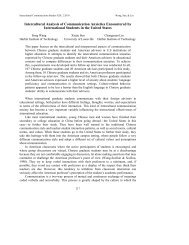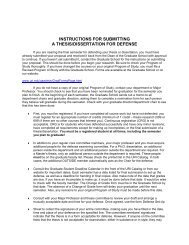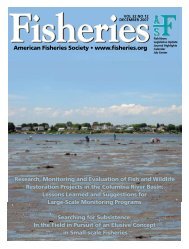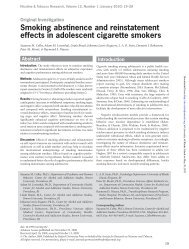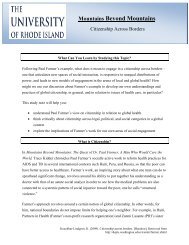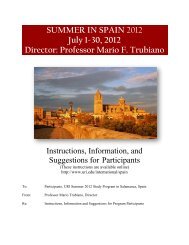Appendix A Standard Operating Procedures - University of Rhode ...
Appendix A Standard Operating Procedures - University of Rhode ...
Appendix A Standard Operating Procedures - University of Rhode ...
You also want an ePaper? Increase the reach of your titles
YUMPU automatically turns print PDFs into web optimized ePapers that Google loves.
Corrective Action<br />
If the %RPD is greater than 20% then the deviation is noted on the data sheet. The processing<br />
time to determine the sample value is greater than the holding time for the samples. Therefore<br />
the samples will not be reanalyzed unless contamination is suspected as shown through a non-<br />
compliant method blank.<br />
5.2.4 Positive Plates<br />
Calibration is completed in a qualitative way through an assessment <strong>of</strong> false negatives.<br />
Bacteria from a known plate <strong>of</strong> E. coli are plated at a dilution <strong>of</strong> 10 -7 using the procedure<br />
outlined under Section 5.2.5.1, steps 1 through 6 and 8 only. The inoculated plates are then<br />
treated as samples and referred to as positive plates; 2 positive plates are prepared per sample<br />
batch. After incubation these plates must exhibit growth.<br />
Corrective Action<br />
The inoculated plates (positive plates) must show growth after incubation. If the plates do not<br />
show growth then it is assumed that the run was in error and the batch <strong>of</strong> samples is<br />
reanalyzed. The field samples will be out <strong>of</strong> compliance with holding times if samples need to<br />
be reanalyzed. This will be noted on the data sheet<br />
5.2.5 Incubators<br />
The temperature <strong>of</strong> the 35 °C and 44.5 °C incubators are checked twice a day at least 4 hours<br />
apart, when in use. Initial and final temperatures for incubations <strong>of</strong> samples are recorded on the<br />
project data reporting sheet (see Section 8.0). The acceptable temperature range for the 35 °C<br />
incubator is 35 +/- 0.5 °C. Acceptable temperature for the 44.5 °C incubator is 44.5 +/- 0.2 °C.<br />
Corrective Action<br />
The incubator temperature must remain in the range specified above. If the incubator<br />
temperature is found to be outside the acceptable range, contact Elizabeth Herron and adjust<br />
the incubator temperature control. Pr<strong>of</strong>essional maintenance <strong>of</strong> the incubator may be<br />
necessary if adjustment <strong>of</strong> the temperature control does not rectify the problem.<br />
5.2.6 Germicidal Unit (UV Box)<br />
The UV light box efficiency will be tested quarterly with a UV light meter. Each lamp will be<br />
tested individually. A lamp will be replaced if it emits less than 70% <strong>of</strong> its initial output. All<br />
efficiency checks will be recorded on the “Quarterly UV Germicidal Tube Record” data sheet<br />
(see Section 8.0 Documentation) and will be available for review.<br />
Corrective Action<br />
If a UV lamp is found to emit less than 70% <strong>of</strong> its initial output then it will be replaced. The date<br />
<strong>of</strong> replacement will be recorded on the efficiency check data sheet.<br />
5.2.7 Sterility Check on Sample Bottles<br />
Sample bottles after sterilization must be checked for sterility before being placed with the<br />
general stock <strong>of</strong> sterilized bottles. A bottle sterility check will be completed at a frequency <strong>of</strong><br />
one sample bottle per sterilization run. Sterility checks will be completed by selecting one<br />
sterilized sample bottle at random after the sterilization run has been completed. The sample<br />
bottle will then be filled with Ultrapure water capped and mixed. Once the water has been<br />
7 <strong>of</strong> 23<br />
Ambient Waters Microbiological Procedure SOP 007<br />
S:\WW\awwword\LABPROC\all QAPPs\LABQAPPs\QAPP Rev5 -0609\SOPs\SOP 007AmbientMicrobes.doc



